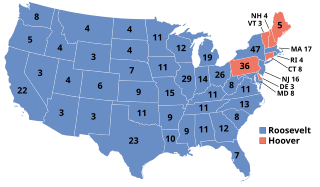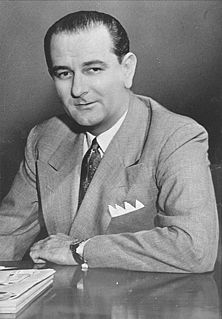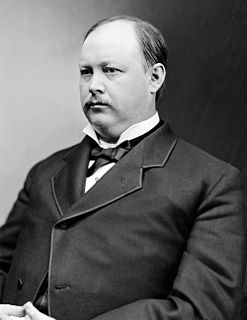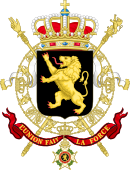
The United States presidential election of 1932 was the thirty-seventh quadrennial presidential election, held on Tuesday, November 8, 1932. The election took place against the backdrop of the Great Depression. Incumbent Republican President Herbert Hoover was defeated in a landslide by Democrat Franklin D. Roosevelt, the Governor of New York. The election marked the effective end of the Fourth Party System, which had been dominated by Republicans.

The United States Electoral College is a body of electors established by the United States Constitution, constituted every four years for the sole purpose of electing the president and vice president of the United States. The Electoral College consists of 538 electors, and an absolute majority of 270 electoral votes is required to win an election. Pursuant to Article II, Section 1, Clause 2, the legislature of each state determines the manner by which its electors are chosen. Each state's number of electors is equal to the combined total of the state's membership in the Senate and House of Representatives; currently there are 100 senators and 435 representatives. Additionally, the Twenty-third Amendment provides that the District of Columbia (D.C.) is entitled to a number of electors no greater than that of the least populous state.

The United States Senate elections, 1962 was an election for the United States Senate which was held in the middle of President John F. Kennedy's term. His Democratic Party made a net gain of three seats from the Republicans, increasing their control of the Senate.

The 1960 United States Senate elections coincided with the election of John F. Kennedy as president. The Republicans gained one seat at the expense of the Democrats. The Democrats nonetheless retained a commanding lead in the Senate with 64 seats to 36. As Majority Leader Lyndon B. Johnson was elected Vice President, Mike Mansfield became the new Majority Leader.

The United States Senate elections of 1956 were elections for the United States Senate that coincided with the re-election of President Dwight D. Eisenhower. Although the Democrats gained two seats in regular elections, the Republicans gained back two seats in special elections, leaving the party balance of the chamber remained unchanged.

The United States Senate elections of 1950 occurred in the middle of Harry S. Truman's second term as President. As with most 20th-century second-term mid-terms, the party out of the Presidency made significant gains. The Republican opposition made a net gain of five seats, taking advantage of the Democratic administration's declining popularity during the Cold War and the aftermath of the Recession of 1949. The Democrats held a narrow 49 to 47 seat majority after the election. This became the first time since 1932 that the Senate Majority Leader lost his seat and the only instance where the majority leader lost his seat while his party retained the majority.

The United States Senate elections of 1946 were held November 5, 1946, in the middle of Democratic President Harry S. Truman's first term.

The United States Senate elections of 1924 were elections for the United States Senate which coincided with the election of Republican President Calvin Coolidge to a full term. The strong economy and Coolidge's popularity helped Republican candidates increase their majority by four, although several interim appointments had worsened their numbers since the 1922 election; as a result, the party achieved a net gain of only one seat since the previous voting cycle.

The United States Senate elections of 1920 were elections for the United States Senate that coincided with the election of Warren G. Harding as President. There was also a special election in 1921. Democrat Woodrow Wilson's unpopularity allowed Republicans to win races across the country, winning ten seats from the Democrats, providing them with an overwhelming 59 to 37 majority. The Republican landslide was so vast that the Democrats failed to win a single race outside the South.

The 1992 United States House of Representatives elections coincided with the 1992 presidential election, in which Democrat Bill Clinton was elected as President, defeating Republican incumbent President George H. W. Bush.

Elections to the United States House of Representatives held in 1888 were held to choose members of the 51st Congress, and were held at the same time as the election of President Benjamin Harrison.

The 2007 United States elections were held on Tuesday, November 6. During this off-year election, the only seats up for election in the United States Congress were special elections held throughout the year. None of these congressional seats changed party hands. There were also several gubernatorial races and state legislative elections, and numerous citizen initiatives, mayoral races in several major cities, and several types of local offices on the ballot.

The 2003 United States elections, most of which were held on Tuesday, November 4, were off-year elections in which no members of the Congress were standing for election. However, there were three gubernatorial races, state legislative elections in four states, numerous citizen initiatives, mayoral races in several major cities, and a variety of local offices on the ballot.

The 2002 United States elections were held on November 5, in the middle of Republican President George W. Bush's first term. Unusual in midterm elections, the incumbent president's party gained seats in both chambers of the United States Congress. The Republicans picked up net gains of 2 Senate seats and 8 House seats.

The 2009 United States elections were held on Tuesday, November 3. During this off-year election, the only seats up for election in the United States Congress were special elections held throughout the year. In total, only the seat representing New York's 23rd congressional district changed party hands, increasing the Democratic Party's majority over the Republicans in the United States House of Representatives, 258–177.

The 2001 United States elections were held on November 5 of that year. The 2001 recession was a dominant issue throughout the year as well as to a lesser extent the September 11 attacks and subsequent War on Terror, the latter of which would become especially important issue in the next year.

The 1996 United States elections were held on November 5. Democratic President Bill Clinton won re-election, while the Republicans maintained their majorities in both houses of the United States Congress.
The United States Senate elections of 1872 and 1873 were elections which had the Republican Party, while still retaining a commanding majority, lose two seats in the United States Senate. By the beginning of the Congress, however, they'd lost three more: two as defections to the Liberal Republican Party, and one a resignation of Henry Wilson to become U.S. Vice President. These elections also coincided with President Ulysses S. Grant's easy re-election.
The United States Senate elections of 1868 and 1869 were elections which had the Republican Party maintain their majority in the United States Senate. However, six former Confederate states were also readmitted separately from the general election, each electing two Republicans. This increased the Republicans' already overwhelming majority to the largest number of seats ever controlled by the party.

The 1999 United States elections, which were held on Tuesday, November 2, were off-year elections in which no members of the Congress were standing for election. However, there were three gubernatorial races, state legislative elections in four states, numerous citizen initiatives, mayoral races in several major cities, and a variety of local offices on the ballot.

















